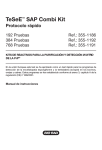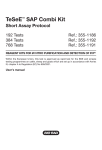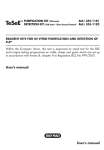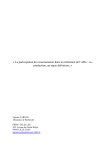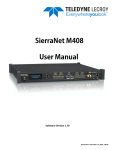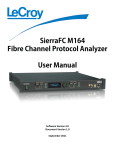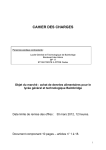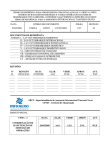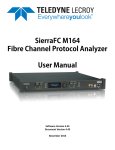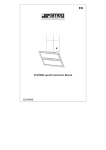Download USER'S MANUAL EVALUATION CONTINUING
Transcript
USER’S MANUAL for the EVALUATION of CONTINUING EDUCATION and CONTRACT TRAINING Contract Training and Marketing Society Ministry of Advanced Education, Training and Technology BARBARA BOWMAR REED EARLY GARTH HOMER MAY 1999 Canadian Cataloguing in Publication Data Bowmar, Barbara. User’s manual for the evaluation of continuing education and contract training Includes bibliographical references: p. 14 ISBN 0-7718-9546-1 1. Continuing education centres - British Columbia – Evaluation. 2. Employees – Training of – Contracting out – British Columbia – Evaluation. I. Early, Reed Spencer. II. Homer, Garth. III. British Columbia. Ministry of Advanced Education, Training and Technology. IV. Contract Training and Marketing Society. V. Title. LC5219.B68 1999 374’.9711 C99-960176-8 For further information, please contact: Contract Training and Marketing Society 1483 Douglas Street, 6th floor, Victoria, B.C. V8W 3K4 (250) 413-4462 (250) 413-4463 fax [email protected] Copyright © 1999 Ministry of Advanced Education Training and Technology Contents Glossary . . . . . . . . . . . . . . . . . . . . . . . . . . . . . . . . . . . . . . . . . . . . . . . . . . . . . . . . . . . . 1 Introduction . . . . . . . . . . . . . . . . . . . . . . . . . . . . . . . . . . . . . . . . . . . . . . . . . . . . . . . . . . 2 How and When to Use this Manual . . . . . . . . . . . . . . . . . . . . . . . . . . . . . . . . . . . . . . . 2 Evaluation Framework . . . . . . . . . . . . . . . . . . . . . . . . . . . . . . . . . . . . . . . . . . . . . . . . . 3 Performance Measurement versus Evaluation . . . . . . . . . . . . . . . . . . . . . . . . . . . . . . 3 Evaluation Steps . . . . . . . . . . . . . . . . . . . . . . . . . . . . . . . . . . . . . . . . . . . . . . . . . . . . . . 4 Step 1 Step 2 Step 3 Step 4 Step 5 Step 6 Step 7 Step 8 Plan for the Evaluation . . . . . . . . . . . . . . . . . . . . . . . . . . . . . . . . . 5 Form a Steering Committee for the Evaluation and Assign Roles 6 Decide Boundaries of Evaluation, Inclusions and Exclusions . . . 7 Gather or Create Objectives, Indicators, Measures and Targets . 8 Gather or Create Performance Measurement Matrices . . . . . . . . 9 Evaluate Performance Measurement Matrices . . . . . . . . . . . . . . 10 Decide Next Steps to Develop Performance Measurement . . . . 11 Write Report of Evaluation . . . . . . . . . . . . . . . . . . . . . . . . . . . . 12 Conclusion . . . . . . . . . . . . . . . . . . . . . . . . . . . . . . . . . . . . . . . . . . . . . . . . . . . . . . . . . 13 References . . . . . . . . . . . . . . . . . . . . . . . . . . . . . . . . . . . . . . . . . . . . . . . . . . . . . . . . . 14 Appendix I Evaluation Framework Appendix II Checklists Suggested Outline of Final Report Appendix III Worksheets Appendix IV Evaluation Standards Appendix V Examples from Continuing Education and Contract Training Appendix VI Literature Analysis CE/CT Unit Review User’s Manual page 1 Glossary Unit Department, division or institutional area which functions to provide CE/CT Mission General statement of what the unit provides, and to whom Goal The desired state which the unit ultimately aims toward Objective Simple measurable statement directly related to the goal indicating desired change Activity Action the unit undertakes to fulfill its mission, goal and objectives Input Resources devoted to activities, ie. staff, space, funding, overhead costs Output Measure of unit activities Reach Output Population and region served, response to requests Relevance Output Appropriateness of programming, types of courses, certificates and offerings Outcome Measure of the results of unit activities, outputs, or other more immediate outcomes Educational Outcome Measure of the skills, knowledge and experience resulting from the unit’s activities, outputs, or other more immediate outcomes Financial Outcome Measure of the financial results of the unit’s activities, outputs, or other more immediate outcomes Ratio Rate of one input, output or outcome in proportion to another Performance Indicator Output, outcome or ratio judged important to the success of the program Performance Measure Clear, precise, operational statement of how a performance indicator is to be measured Efficiency Indicator Number of output or outcome units achieved per unit of input Effectiveness Indicator Number of intended outcome units achieved per unit of output Performance Measurement Identification and measurement of carefully chosen indicators to provide feedback on performance Performance Management The use of performance measurement to inform management decisions affecting performance CE/CT Unit Review User’s Manual page 2 Introduction This manual was developed in response to a request by the British Columbia Deans and Directors of Continuing Education who saw the need to provide a conceptual evaluation framework appropriate to Continuing Education and Contract Training and to provide practical examples and steps for those charged with carrying out an evaluation of their units. Continuing Education and Contract Training Units in educational institutions in British Columbia function in a variety of organizational structures, their mandates within institutions vary, and the staff who head the units come from a variety of backgrounds. Some are skilled in evaluation work, while for others the experience is relatively new. Both a consultative process and an analysis of current literature and practice were used by the writers in developing the Evaluation Framework which can be found in Appendix I. A checklist of the steps to be taken in an evaluation are provided in Appendix II, and worksheets are included in Appendix III. The standards for educational evaluation are included in Appendix IV. Example applications to Continuing Education and Contract Training are in Appendix V. The literature analysis can be found in Appendix VI. This manual is intended to be descriptive rather than prescriptive. It allows the Continuing Education or Contract Training Unit carrying out an evaluation to adapt the material to its unique situation. For example, institutions vary widely in the degree and extent to which they use participatory processes in evaluation. Each institution will make implementation decisions consistent with its philosophy and practice. Institutions are autonomous and will recognize that this framework is one of many possible models and that it may form the entire evaluation or a portion of an evaluation which incorporates other tools as well. How and When to Use this Manual When a Continuing Education or Contract Training Unit is preparing to undergo an evaluation, it is suggested that those responsible for the evaluation read this manual. There are many decisions to be made in the early stages of the evaluation and the more familiar personnel are with the implications of those decisions the more successful and useful the evaluation will be. Once the reader has reviewed the summary of the Evaluation Framework and the comments on the difference between evaluation and performance measurement in the paragraphs which follow, the reader should turn to Appendix I. An understanding of the Evaluation Framework is important to the implementation steps which follow. The reader is then directed to review the practical steps commencing on page 4. CE/CT Unit Review User’s Manual page 3 Evaluation Framework Traditionally evaluation has focussed on units delivered, e.g., the number of classes or programs offered, the number and value of contracts, and the number of students served. This emphasis is changing. Continuing Education and Contract Training Units are increasingly becoming accountable for results. The Evaluation Framework used in this manual operates from the premise that Performance Measurement (PM) is the best approach to generate the required information. In this framework, periodic evaluation serves an audit function, assessing the development of the ongoing PM system and the areas for improvement in that system. For an expanded discussion of the role of evaluation in comprehensive audit see Leclerc, Moynagh, Boisclair, and Manson (1996). The Evaluation Framework was developed as an accountability tool, formative in function and intended to result in better performance management. The principles of adaptability, flexibility and responsiveness are applied. The findings are intended to be action based and easily understood. Performance Measurement versus Evaluation Performance Measurement is ongoing, and is analogous to a road, along which are indicators or sign posts marking points at which to assess the unit’s functioning. Continuing with the analogy, evaluation assesses the road. Evaluation is really a procedure of taking stock. It points to areas for improvement in the PM system and increases the utility of the results. The scope and depth of evaluation, and its resulting recommendations, will largely depend on the stage of development of the unit’s PM system. Before going to the Evaluation Steps in the next section, refer to Appendix I, Evaluation Framework. CE/CT Unit Review User’s Manual page 4 Evaluation Steps Below is a pictorial representation of the eight steps to evaluate a CE/CT unit. They are a straightforward progression of items, each checked against the standards in Appendix IV. The steps are defined in relation to the tasks and deliverables and may overlap to the extent that the tasks are concurrent. A major decision point exists after Step 3, in which the unit determines if it already has a PM system or will need to create a new system. Units which have already implemented a PM system may eliminate Steps 4 and 5. The evaluation steps shown here are reviewed in detail on the following pages. Figure 1 Steps to Evaluation of the CE/CT Unit 1. Plan for the Evaluation 2. Form Steering Committee 3. Decide Boundaries PM System currently in place No 4. Create Objectives, Indicators, Measures and Targets Yes 6. Evaluate PM Matrices 7. Next Steps to PM System 8. Write Evaluation Report 5. Create Performance Measurement Matrices CE/CT Unit Review User’s Manual page 5 Step 1 Plan for the Evaluation Adequate forethought will ensure that an evaluation meets its objectives. Thorough planning will prevent problems later. Some of the items which follow are common sense and this list merely serves as a reminder of the considerations which need to be taken into account. See also the accompanying list in Appendix II. A. Define the purpose of the evaluation. B. Devise a communication plan(s) for use within the unit, to communicate with the senior administration in the institution and with appropriate external stakeholders. C. Review the unit mission statement. Ensure that it is current. D. Establish a time line. E. Establish a task list and indicate responsibility for each item. F. Assess the human, financial, technical, and equipment resources for the evaluation. G. Determine what data is on hand. H. Develop a clear and concise statement of the challenges facing the unit, e.g., changes or signs of changes in student enrolment, client needs, the economic situation, the impact of recent or pending legislative changes, changes in expectations of the organization or stakeholders and clients. I. Decide how the evaluation recommendations will be used. J. Decide who will have the responsibility for implementing the recommendations. K. Determine the format of the final product. L. Consider the next steps after the completion of this evaluation. CE/CT Unit Review User’s Manual page 6 Step 2 Form a Steering Committee for the Evaluation and Assign Roles The steering committee should be appointed early and meet frequently during the process. The committee can help to: A. Address concerns relating to the utility, propriety, feasibility and accuracy standards. B. Reduce the potential for conflict of interest which may occur, particularly if the administrator is evaluating his or her own unit. C. Increase the possibility that the evaluation will be used by having stakeholders involved in the steering committee. Very early in the process the person(s) responsible for the evaluation should: D. Decide on the composition of the steering committee. E. Decide who are the important stakeholders to be included. F. Determine terms of reference for the steering committee. G. Determine the number of people to be on the steering committee. H. Provide an orientation for the steering committee by defining the nature of the task and the involvement and commitment of each member. Much of the material needed for the orientation will have been developed in the planning step. I. Define a source for resources/consulting on Performance Measurement. J. Assign roles and responsibilities. CE/CT Unit Review User’s Manual page 7 Step 3 Decide the Boundaries of the Evaluation, both Inclusions and Exclusions In order to limit the scope of the evaluation the steering committee should: A. Define the interests and requirements of the individuals or agencies both internal and external to whom the report will eventually be directed. B. List the issues that are of particular importance to the unit. C. Identify known pressures on the unit. D. Review any policy or planning initiatives, known or expected, which will impact on the unit. E. Identify other performance review processes which are required by internal or external bodies which may overlap or impact on the process. F. Select a modest number of the most important indicators. A suggested upper limit is forty (40) performance indicators for a unit. Any individual employee or department within the unit should not be working on more than ten (10) at any given time. G. Assess the existing information and decide whether to evaluate on the basis of that information and identify gaps, weaknesses or redundancies. If necessary, develop new measures. See Figure 1 and consult Appendix V as well. H. Identify the key assessment factors which seem reasonable in terms of their accountability or potential for assisting in decision making, improving the unit functioning, or assisting with advocacy strategies for the unit. DECISION POINT Institutions or units which have been developing performance indicators, measures and targets over several years may have sufficient information on hand and will not need to carry out Steps 4 and 5 but will proceed to Step 6. It is suggested that the checklists for Steps 4 through 8 be consulted before the decision is made. See Appendix II. CE/CT Unit Review User’s Manual page 8 Step 4 Gather or Create Objectives, Performance Indicators, Measures and Targets The steering committee will gather the necessary Performance Measurement information, or ensure that it is gathered or created. They will: A. Review the definitions of objectives, performance indicators, measures and targets which are contained in the Glossary of this manual and ensure that the terms are understood. B. Use the considerations in Step 3 as the writing of the elements progresses. C. Ensure the systems are in place to allow for the collection of the desired performance measurement data. If the systems are not in place, begin formulating recommendations for their creation and implementation. D. Identify the necessary data sources: clients (students, faculty, staff, contracting agency) and other stakeholders (funding agencies, employers, potential employers, professional associations). E. Review and gather any existing data or Performance Measurement indicators. CE/CT Unit Review User’s Manual page 9 Step 5 Gather or Create Performance Measurement Matrices Examples of Performance Measurement matrices for Continuing Education and Contract Training are presented in Appendix V. Blank work sheets are included in Appendix III. Construct matrices with the following four criteria in mind: Utility Feasibility Propriety Accuracy Is it usable by the intended recipients? Is it possible to collect the data? Are processes ethical and accessible? Does it meet the definition and requirements of the Performance Measurement system? An expanded discussion of the four Program Evaluation Standards and their application can be found in Appendix IV. See also the Joint Committee on Standards for Educational Evaluation (1994). The figure below demonstrates how the four program standards impact the evaluation of Performance Measurement. Readers are referred to Appendix I (page 2) which uses the analogy of a road as ongoing Performance Measurement. Evaluation is a vehicle which travels that road to determine how far the road goes and along the way to note the sign posts, performance indicators and areas for improvement. The four program standards are applied to that evaluation. Figure 2 Application of Performance Evaluation Standards CE/CT Unit Review User’s Manual page 10 Step 6 Evaluate Performance Measurement Matrices The matrices should be scrutinized by doing the following: A. Apply the four program standards: utility, feasibility, propriety and accuracy to each line item on the matrices as outlined in Appendix IV of this manual. B. Determine whether each of the indicators considered is essential to an understanding of the effectiveness of this unit. C. Decide if there are sufficient indicators to track the performance of this unit. D. Determine if any other indicators are needed to complete the logic. E. Review indicators to determine if there is a logic which connects them. Is the logic evident or does it need some explanation? F. Determine if a clear rationale exists for the targets which are being applied. CE/CT Unit Review User’s Manual page 11 Step 7 Decide Next Steps to Develop Performance Measurement System The optimal Performance Measurement system and the unit’s current Performance Measurement system are compared. The unit should then: A. Identify gaps in the system. B. Decide which of the missing information is the highest priority for collection. C. Design and implement systems to collect the information. D. Determine what necessary compromises in the system must be made because of the constraints identified earlier. CE/CT Unit Review User’s Manual page 12 Step 8 Write Report of Evaluation The final report (see Appendix II) should include the following: & Status of Performance Measurement implementation to date. & Revised Performance Measurement matrix or matrices. & Recommendations for changes or additions to performance indicators. & Recommendations for improvements to PM system based on the data collected and the methods of analysis. The final report should address each element after a thorough analysis of the data and it should develop conclusions and recommendations which are: & Written in clear and concise language. & Adequately explained. & Based on a review and analysis of the data. & Supported by a rationale. CE/CT Unit Review User’s Manual page 13 Conclusion An understanding of the conceptual basis for the Evaluation Framework followed by careful application of the above steps forms the basis of a useful experience for all involved in the evaluation process. The Performance Measurement systems used in an ongoing manner by Continuing Education and Contract Training should demonstrate their worth to their institutions and related communities in terms of their relevance, appropriateness, impact and efficiency. In addition to determining whether or not the Continuing Education Unit is currently successful, the Performance Measurement system must be assessed to determine if it measures how well the Continuing Education Unit or Contract Training Unit is positioned for future success. CE/CT Unit Review User’s Manual page 14 References Joint Committee on Standards for Educational Evaluation. (1994). The Program Evaluation Standards. Kalamazoo, Michigan: The Evaluation Center, Western Michigan University. Leclerc, G., Moynagh, D., Boisclair, J. P., & Manson, H.R. (1996). Accountability, Performance Reporting, Comprehensive Audit: An Integrated Perspective. Ottawa: CCAF-FCVI Inc. LERN. (1998). Program Review and Audit Certification. Kansas: LERN. Unpublished manuscript.

















